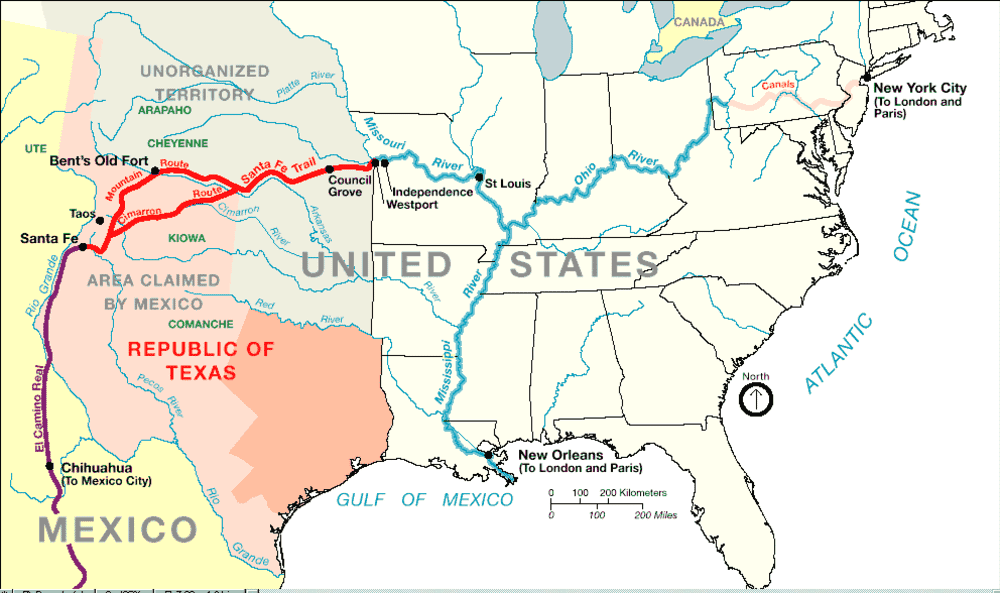In 1821, a Missouri judge gave William Becknell one year to pay off $20,000* in debt. If he failed, the recently freed Becknell would have to return to prison. Then 33 years old, a former soldier accustomed to a life of hunting and trading, Becknell was determined to best his creditors and provide for his young family.
He placed an ad in the Missouri Intelligencer newspaper calling for participants on a journey to the West, "for the purpose of trading for Horses and Mules and catching Wild Animals of every description". In September, Becknell departed with a team of five men, their pack mules loaded with cloth and wares.
They followed a similar route taken by French frontiersman Pedro Vial, who nearly 30 years earlier had blazed a trail from Missouri to Santa Fe by request of the Spanish government. The party crossed Missouri, Colorado, Kansas, and Oklahoma in about two and a half months, reaching Santa Fe on November 16, 1821. They sold their mules and goods for a handsome profit, allowing Becknell to repay his debts and fund a second, even more successful trip to New Mexico the year after.
Awestruck at Becknell’s great fortunes, countless other tradesmen set off for the West, following a 900 mile route across the Great Plains that linked Franklin, Missouri to Santa Fe, New Mexico - a commercial highway that came to be known as the Santa Fe Trail.
For nearly sixty years, trade boomed along the Trail. American mules, long-horn cattle, clothing, and tools were exchanged for Mexican silver and gold, and the influx of hard money revitalized the small towns that dotted the area. The Trail was used by missionaries, tradesmen, soldiers, and frontiersman alike, also serving as a popular route during the California gold rush.
The majority of the Trail followed one path, eventually splitting up into two branches in western Kansas: the Cimarron Route and the Mountain Branch.
Most travelers chose to follow the Cimarron Route, for it was shorter and easier to cross. Attacks from indigenous tribes were not uncommon, however, as the route encroached the homelands of the Apache and Comanche peoples. And freshwater was scarce in the dry and arid region. After using up all their water supply, the members of one trading party (disputed to be either Colonel Benjamin Cooper’s or Becknell’s) had to kill their mules and wild buffalo, staving off dehydration by drinking the animals’ blood and stomach contents.
The less popular Mountain Branch cut through the Raton Pass - a treacherous mountain pass that runs along the Colorado-New Mexico border. This is the route that Becknell followed on his first expedition, and although the journey through the mountains was arduous, there was ample freshwater along the way.
Regardless of the path, a caravan of wagons took about 8 to 10 weeks to go from Missouri to New Mexico. Based on accounts left by some of the individuals who went down the Trail, we know the journey was by turns monotonous and difficult. Indeed, inclement weather, lack of food and water, and attacks from native tribes were occasional threats, but the majority of the trip was uneventful and slow-going, with little else to do but drive the wagons ever westward. Over 900 miles of unchanging grasslands served as a constant backdrop along the way, leading one traveler to remark that the massive plains seemed to “heave[] and roll[] around like a green ocean".
Ultimately, the completion of the Atchison, Topeka, and Santa Fe Railroad in 1880 marked the end of the Trail’s use as a footpath. Since then, more construction has followed suite, and great stretches of the original Trail now lie buried under industrial sprawl.
Although much has changed in the world since William Becknell and his small company first set out for Santa Fe in 1821, the heart of the land remains the same. On the endless plains where herds of bison have once again returned to their pastures of old, where thundering locomotives follow the same paths forged by caravans of hopeful men and women who sought their fortunes beyond the shimmering desert, here the mountains still reach up in praise towards the New Mexico sky.
*Becknell owed around $1,200, which amounts to approximately $20,000 today
Learn More
Despite having been recognized by congress in 1987 as a National Historic Trail, you can no longer hike along the original Santa Fe Trail from start to finish, as much of it rests on private land or has been covered by railroads or highways. The National Park Service currently administers the Trail, and their website provides a number of resources for those interested in tracing the footsteps of 19th century frontiersmen.
The Santa Fe Trail Association is a non-profit organization whose goal is to preserve and celebrate the original Santa Fe Trail. Founded in 1986 and comprised of over 16 chapters in five states, the SFTA regularly hosts events to educate the public on the Trail as well as on other important events in the history of the West.
References
https://www.nps.gov/safe/faqs.htm
https://www.nps.gov/safe/learn/historyculture/index.htm
https://www.nps.gov/safe/learn/historyculture/stories.htm
https://www.history.com/topics/westward-expansion/santa-fe-trail
http://williambecknell.com/?page_id=202
https://www.legendsofamerica.com/we-williambecknell/
https://www.legendsofamerica.com/we-santafetrailroutes/
https://www.legendsofamerica.com/we-santafetrailinternationaltrade/
https://www.legendsofamerica.com/we-santafetrailrailroad/
https://www.okhistory.org/publications/enc/entry.php?entry=BE009
https://www.encyclopedia.com/science/encyclopedias-almanacs-transcripts-and-maps/pedro-vial-charts-santa-fe-trail-and-opens-southwest-exploration-and-trade
https://www.nps.gov/nr/travel/american_latino_heritage/Raton_Pass.html
https://commons.wikimedia.org/wiki/File:1845_trailmap.png
.png&w=640&q=75)
